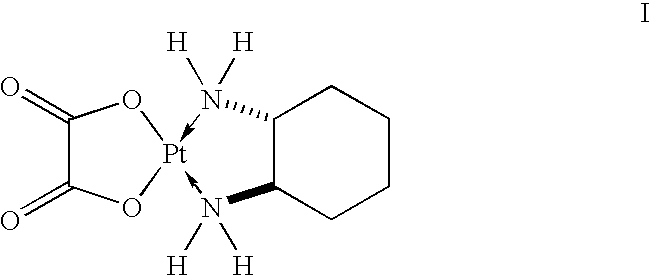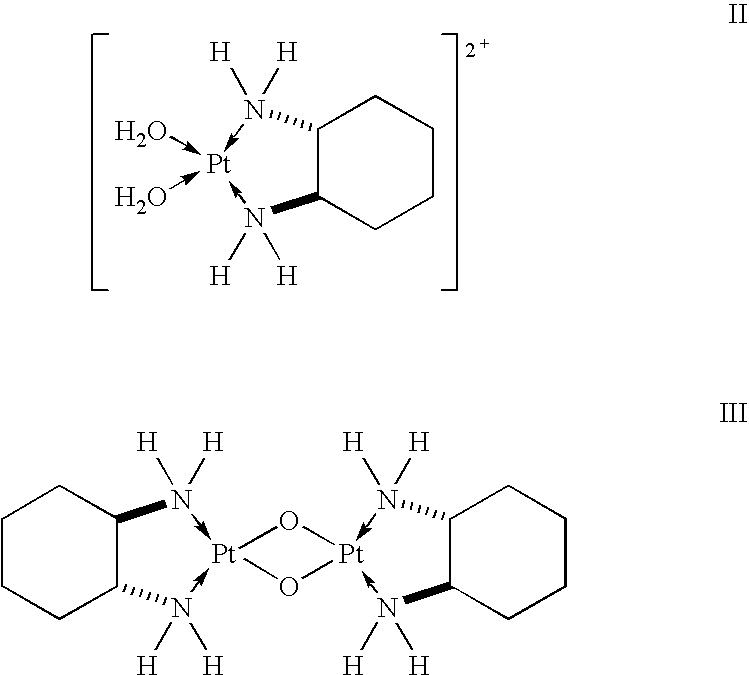Ready-to-use oxaliplatin solutions
- Summary
- Abstract
- Description
- Claims
- Application Information
AI Technical Summary
Benefits of technology
Problems solved by technology
Method used
Image
Examples
example 1
Comparative Experiments Regarding the Stability of Aqueous Oxaliplatin Solutions Without Additional Additives According to European Patent EP 0 774 963
[0033] To determine the stability of unstable oxaliplatin solutions known from European Patent EP 0 774 963, oxaliplatin solutions (C=2.0 mg / ml, with water for injection purposes as the solvent) were stored under exclusion of light at temperatures between 20-25° C., and the relative concentrations of the oxaliplatin degradation products diaquo DACH platinum (II) and diaquo DACH platinum dimer (III) were measured using time-resolved HPLC. The amount of the degradation product oxalic acid is calculated from the amount of platinum-containing degradation products. The results of these investigations are compiled in Table 1.
TABLE 1Stability of oxaliplatin solutions (C = 2.0 mg / ml) without other additives.The resulting pH is 6.6; storage temperature: 20-25° C.Diaquo DACHDiaquo DACHplatinum dimerplatinum (II)a(III)aOxalic acidbDuration (h...
example 2
Comparative Experiments Regarding the Stability of Aqueous Oxaliplatin Solutions Stabilized by Adding Oxalic Acid According to European Patent EP 0 943 331, Phosphoric Acid, or Sulfuric Acid
[0036] Stability obtained by adding phosphoric acid and sulfuric acid was compared to the stability obtained by adding the corresponding isoionic acid (oxalic acid) known from the related art. European Patent EP 0 943 331 discloses that stable aqueous oxaliplatin solutions (having the known disadvantages) may be obtained by adding oxalic acid.
[0037] The influence of the pH and the selected acid on stabilization was investigated using test batches produced at 20-25° C. and stored at 60° C. in which the concentration of oxaliplatin was C=6.6 mg / ml in all the series of experiments, the pH being adjusted using 1 N phosphoric acid and 1 N sulfuric acid in comparison to 1 N oxalic acid. 33 mg oxaliplatin in 5.0 ml solvent having a previously set pH (water for injection purposes having a pH preset usi...
example 3
Comparative Experiments Under Real Conditions Regarding the Stability of Aqueous Oxaliplatin Solutions with the Addition of Oxalic Acid, Phosphoric Acid, and Sulfuric Acid in a Limited pH Range
Experimental Design
[0048] The test batches were produced at 15-20° C. by dissolving the corresponding amount of oxaliplatin (C=1 mg / ml and C=6.6 mg / ml), water previously adjusted to the target pH (3.5-4.0-5.0) using q.s. 1N oxalic acid, 1N phosphoric acid, and 1N sulfuric acid used for injection purposes as the solvent.
[0049] The obtained test batches were sterile filtered after the first purity analyses, aseptically poured into injection vials, incubated protected from light at 2-8° C., and reanalyzed at the above times. The pH was determined by measuring potential at all times.
[0050] To compare the degree of stabilization of oxaliplatin solutions according to the invention to other acids beside oxalic acid, the stability obtained by adding phosphoric acid and sulfuric acid was compared ...
PUM
 Login to View More
Login to View More Abstract
Description
Claims
Application Information
 Login to View More
Login to View More - R&D
- Intellectual Property
- Life Sciences
- Materials
- Tech Scout
- Unparalleled Data Quality
- Higher Quality Content
- 60% Fewer Hallucinations
Browse by: Latest US Patents, China's latest patents, Technical Efficacy Thesaurus, Application Domain, Technology Topic, Popular Technical Reports.
© 2025 PatSnap. All rights reserved.Legal|Privacy policy|Modern Slavery Act Transparency Statement|Sitemap|About US| Contact US: help@patsnap.com


